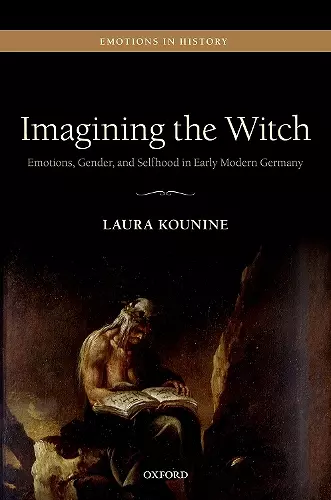Imagining the Witch
Emotions, Gender, and Selfhood in Early Modern Germany
Format:Hardback
Publisher:Oxford University Press
Published:13th Nov '18
Currently unavailable, and unfortunately no date known when it will be back

Imagining the Witch explores emotions, gender, and selfhood through the lens of witch-trials in early modern Germany. Witch-trials were clearly a gendered phenomenon, but witchcraft was not a uniquely female crime. While women constituted approximately three quarters of those tried for witchcraft in the Holy Roman Empire, a significant minority were men. Witchcraft was also a crime of unbridled passion: it centred on the notion that one person's emotions could have tangible and deadly physical consequences. Yet it is also true that not all suspicions of witchcraft led to a formal accusation, and not all witch-trials led to the stake. Indeed, just over half the total number put on trial for witchcraft in early modern Europe were executed. In order to understand how early modern people imagined the witch, we must first begin to understand how people understood themselves and each other; this can help us to understand how the witch could be a member of the community, living alongside their accusers, yet inspire such visceral fear. Through an examination of case studies of witch-trials that took place in the early modern Lutheran duchy of Württemberg in southwestern Germany, Laura Kounine examines how the community, church, and the agents of the law sought to identify the witch, and the ways in which ordinary men and women fought for their lives in an attempt to avoid the stake. The study further explores the visual and intellectual imagination of witchcraft in this period in order to piece together why witchcraft could be aligned with such strong female stereotypes on the one hand, but also be imagined as a crime that could be committed by any human, whether young or old, male or female. By moving beyond stereotypes of the witch, Imagining the Witch argues that understandings of what constituted witchcraft and the 'witch' appear far more contested and unstable than has previously been suggested. It also suggests new ways of thinking about early modern selfhood which moves beyond teleological arguments about the development of the 'modern' self. Indeed, it is the trial process itself that created the conditions for a diverse range of people to reflect on, and give meaning, to emotions, gender, and the self in early modern Lutheran Germany.
Kounine has produced a series of excellent case histories that reveal how difficult it was to detect or prove the guilt of someone whose crime, if any, was internal. * H. C. Erik Midelfort, Journal of Modern History *
...her book deserves attention for her insightful and intriguing views. Kounine combines innovative approaches to key issues in the witch hunt literature with a careful reading of archival sources. This work also does a remarkable job of leading readers through the main theories on witchcraft such as those of Midelfort, Clark and Roper (many others are mentioned). * Michaela Valente, University of Molise, Emotions *
In these connections lie the book's main significance, not just as a piece of exemplary scholarship in its own right, but as a contribution to several overlapping fields simultaneously: predominantly, and most obviously, the history of witchcraft and history of emotions, but at least three other areas are also illuminated: first, enquiries into selfhood, subjectivity, and phenomenology; secondly, the history of gender and the body; and thirdly, literary and cultural historical investigation of criminal legal records... Laura amplifies the voices of her subjects, and adapts them for our ears, but she doesn't ventriloquize them to suit her purposes. At the same time, she never hesitates or equivocates, and so inspires absolute confidence as a writer. This is intrepid stuff. It's the sort of book that makes the reader wonder whether anyone else could have written such a book in the same nuanced, sophisticated way. * Professor Malcolm Gaskill, University of East Anglia *
ISBN: 9780198799085
Dimensions: 237mm x 164mm x 24mm
Weight: 612g
292 pages